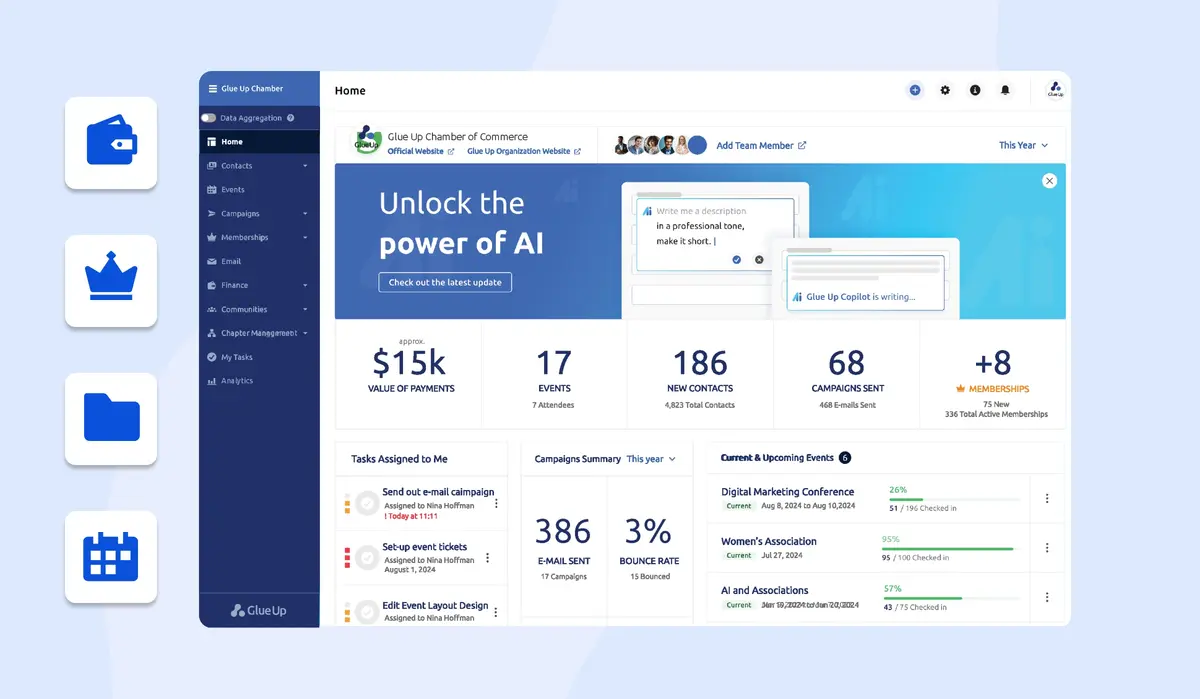
Developing a membership strategy plan is essential if you're aiming to build a strong community around your offerings. But what exactly is a membership strategy, and how can you create an effective plan to execute it?
This article will explore the concept of a membership strategy plan template and provide you with a comprehensive guide on developing one for your organization.
Key Takeaways
- A membership strategy plan is a structured approach to attracting, engaging, and retaining members, serving as a roadmap for cultivating a thriving membership base.
- Implementing a membership strategy plan is crucial, as it can lead to increased membership, improved engagement, higher retention rates, and more data-driven decision-making.
- Key components of a membership strategy plan template include a mission statement, environmental scan, SWOT analysis, goal setting, target audience identification, value proposition development, and marketing and communication plans.
- Creating a membership strategy plan involves assembling a diverse team, conducting thorough research, brainstorming ideas, drafting the plan, seeking feedback, and implementing and monitoring the strategy.
- A successful membership strategy plan should be a living document, regularly reviewed and adjusted based on performance metrics, member feedback, and changing industry trends to ensure continued relevance and effectiveness.
What is a Membership Strategy Plan?

A membership strategy plan is a structured approach that organizations use to attract, engage, and retain members. It serves as a roadmap, outlining the steps necessary to cultivate a thriving membership base.
This plan is particularly relevant in today’s environment, where businesses seek innovative ways to connect with their audiences and foster loyalty.
The core of a membership strategy is understanding your target audience, their needs, and the value the organization can provide. Once you clearly define your goals and objectives, you can align your membership offerings with your mission and vision.
Why Implementing a Membership Strategy Plan is Important?
According to the Membership Marketing Benchmarking Report, 63% of associations reported an increase in membership when they had a strategic plan. This statistic highlights the critical role a well-crafted strategy plays in your organization's success.
Let's break down the key reasons why implementing a membership strategy plan is crucial for your organization:
- Attracting Members: A well-defined strategy helps you identify and reach potential members, ensuring that you can effectively communicate your value proposition.
- Engaging Members: Engagement is crucial for retention. A strategy that includes regular communication and member-exclusive benefits can enhance your member experience.
- Retaining Members: By focusing on member satisfaction and continuously evaluating the strategy, you can foster loyalty and reduce churn rates.
- Data-Driven Decisions: Regular analysis of key performance indicators (KPIs) helps make informed decisions that enhance the membership experience.
Key Components of a Membership Strategy Plan Template
1. Mission Statement
Your membership strategy should align with your organization's overall mission.
Therefore, start by crafting a clear and concise mission statement that describes the purpose of your membership program. This statement should answer questions such as:
- What function or purpose is being performed?
- Who are we serving?
- How will we accomplish our goals?
The mission statement serves as a key component that serves as a guiding principle for decision-making throughout your membership strategy.
2. Environmental Scan
Conduct an environmental scan to analyze factors beyond your organization's control that may impact your membership strategy. Consider economic, technological, political, cultural, social, demographic, and environmental issues relevant to your industry and region.
This "big picture" analysis helps you anticipate challenges and opportunities that may affect your membership program.
3. SWOT Analysis
Perform a SWOT (Strengths, Weaknesses, Opportunities, Threats) analysis to evaluate your organization's internal situation and conditions. This analysis helps you identify:
- Strengths: What your organization does well
- Weaknesses: Areas where your organization lacks resources or expertise
- Opportunities: Potential avenues for growth and improvement
- Threats: Challenges that may hinder your membership program's success
Use the SWOT analysis to inform your strategy and address potential issues proactively.
4. Goal Setting

Define clear, specific, and measurable goals for your membership strategy.
These objectives should be aligned with your organization's overall mission and the results of your environmental scan and SWOT analysis. Examples of membership goals might include:
- Increasing membership growth by a certain percentage
- Improving member retention rates
- Enhancing member engagement through increased participation in events or programs
- Generating a specific amount of revenue through membership fees
5. Target Audience Identification
Clearly define your ideal members by considering their demographics, interests, and pain points. This information will help you tailor your membership offering to meet their specific needs.
Conduct market research and analyze data from existing members to create detailed member personas.
6. Value Proposition Development
Craft a compelling value proposition that clearly articulates the unique benefits your membership program offers. Consider what sets your organization apart from competitors and how your membership addresses the needs and desires of your target audience.
Your value proposition might include:
- Exclusive access to events or resources
- Networking opportunities
- Educational content or professional development
- Discounts on products or services
- Advocacy or representation within the industry
7. Membership Levels and Pricing Strategy
Develop a tiered membership structure that caters to different segments of your target audience. Consider offering various levels of membership with corresponding benefits and pricing.
This approach allows you to appeal to a broader range of potential members while maximizing revenue potential.
8. Marketing and Communication Plan
Outline strategies for promoting your membership program and communicating with both prospective and existing members. This plan should include:
- Identification of key marketing channels (e.g., social media, email, website, direct mail)
- Content strategy for attracting and engaging members
- Frequency and types of communication
- Methods for personalizing communication based on member preferences and behaviors
9. Member Onboarding Process
Design a smooth and welcoming onboarding process for new members.
This process should introduce them to the benefits of membership, guide them through accessing resources, and encourage early engagement with your organization.
10. Engagement and Retention Strategies

Develop tactics to keep members engaged and satisfied throughout their membership journey. Consider implementing:
- Regular surveys to gather feedback and assess member satisfaction
- Personalized content and recommendations based on member interests
- Exclusive events or networking opportunities
- Recognition programs for active or long-standing members
- Continuous improvement of membership benefits based on member feedback
11. Technology and Infrastructure
Identify the technological tools and infrastructure needed to support your membership strategy. This may include:
- Customer Relationship Management (CRM) system
- Member portal or mobile app
- Event management software
- Community management and engagement tools
- Emails and survey creation tools
- Analytics tools for tracking member engagement and program performance
An AMS can integrate many of the above tools into a single, comprehensive platform, streamlining your operations and improving efficiency.
It centralizes your membership data, event management, communication tools, and analytics in one system, so you can enhance your ability to serve members effectively and make data-driven decisions.

One such solution in the market is Glue Up, which offers a suite of tools designed specifically for membership organizations. While there are various AMS options available, Glue Up is the first platform that consolidates all the tech along with advanced AI capabilities.
To learn more about how an AMS like Glue Up could support your membership strategy, you may want to schedule a demo to see the features in action and discuss your organization's unique requirements.
12. Financial Projections and Budgeting
Develop a comprehensive budget that outlines projected income and expenses related to your membership program. Consider factors such as:
- Membership dues revenue
- Event or program income
- Administrative costs
- Marketing expenses
- Technology investments
- Staff or volunteer resources required
Treat your budget as a living document, reviewing and updating it regularly. Ensure that it aligns with your organization's overall financial goals and constraints. Make sure to calculate key financial metrics such as cost per member acquisition and lifetime member value to guide your decision-making.
13. Key Performance Indicators (KPIs) and Evaluation Methods
Establish clear KPIs to measure the success of your membership strategy. These metrics might include:
- Membership growth rate
- Retention rate
- Member engagement levels (e.g., event attendance, resource usage)
- Revenue generated from membership fees
- Member satisfaction scores
Define how and when you will evaluate these metrics, and outline processes for using this data to inform ongoing strategy refinement.
14. Implementation Timeline and Action Plan
Create a detailed timeline for implementing your membership strategy, including specific tasks, responsible parties, and deadlines. Break down the implementation process into manageable phases, allowing for testing and refinement along the way.
15. Contingency Planning
Anticipate potential challenges or roadblocks that may arise during the implementation of your membership strategy. Develop contingency plans to address these issues, ensuring that your organization can adapt to changing circumstances or unexpected obstacles.
Steps to Create a Membership Strategy Plan

Now that we've outlined the key components of a membership strategy plan template, let's explore the process of creating your plan:
1. Assemble a Diverse Team
Bring together representatives from various departments within your organization, including leadership, marketing, member services, and finance. This diverse perspective will ensure a well-rounded approach to your membership strategy.
2. Conduct Thorough Research
Gather data on your current membership (if applicable), industry trends, and competitor offerings. Use surveys, focus groups, and interviews to gain insights from both current and potential members.
3. Brainstorm and Prioritize
Encourage open discussion and creative thinking among your team. Generate a wide range of ideas for each component of your strategy, then prioritize based on feasibility, potential impact, and alignment with your organization's goals.
4. Draft your Plan
Using the template components outlined above, create a draft of your membership strategy plan. Be as specific and detailed as possible, including concrete action items and timelines.
5. Seek Feedback
Share your draft plan with key stakeholders, including board members, staff, and a select group of current members. Incorporate their feedback to refine and improve your strategy.
6. Finalize and Approve
Make final revisions based on feedback, then present your membership strategy plan to your organization's leadership for approval.
7. Implement and Monitor
Begin executing your plan according to the timeline you've established. Regularly monitor progress and collect data on your defined KPIs.
8. Review and Adjust
Conduct periodic reviews of your membership strategy, analyzing performance metrics and gathering ongoing feedback from members. Be prepared to make adjustments as needed to ensure continued success and relevance.
Membership Strategy Plan Template
To jumpstart your process, we've developed a comprehensive membership strategy template incorporating all the key components discussed. You can download this template here and customize it to your organization's specific needs.
Keep in mind that an effective membership strategy is dynamic, not static. Regularly review and update your plan to align with evolving member needs, industry trends, and organizational objectives.
By taking a methodical and thoughtful approach to crafting your membership strategy, you'll be well-equipped to attract, engage, and retain members. This foundation will drive sustainable growth and long-term success for your organization.



